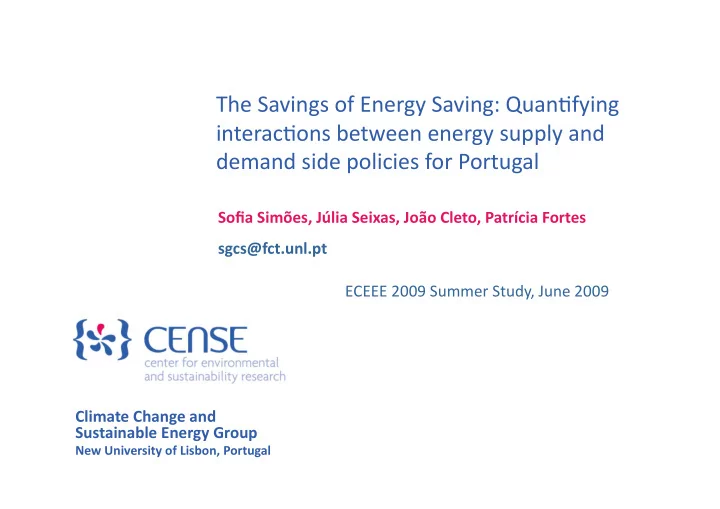

The Savings of Energy Saving: Quan4fying interac4ons between energy supply and demand side policies for Portugal Sofia Simões, Júlia Seixas, João Cleto, Patrícia Fortes sgcs@fct.unl.pt ECEEE 2009 Summer Study, June 2009 Climate Change and Sustainable Energy Group New University of Lisbon, Portugal
Overview → Objec4ve & Context → Methods ► Studied scenarios ► TIMES_PT model → Results ► Avoided electricity genera4on capacity ► Final energy consump4on & share of renewables ► GHG emissions → Conclusions and limita4ons
ObjecLve & Context ► What are the gains of end‐use energy‐efficient & small renewable applica4ons in residen4al and commercial (and industry) regarding: reduced investments in energy supply contribu4on for compliance with energy and environmental policy targets (energy‐climate policy package) Case‐study Portugal in 2020 with focus on residen4al & commercial sectors external energy dependency (87%) increasing GHG emissions stepped up efforts on - RES (double 2005 capacity by 2020) - NEAAP (10% final energy by 2015) - expansion of CCGT capacity (73% increase of 2005 capacity )
Methods | studied scenarios (2020) BAU E‐FRE BAUeff EFREeff E‐FRE capacity (MW) 10424 13426 10424 13426 CCGT capacity (MW) 4376 Min. CCGT acLvity 37% _ 37% _ 9% of households and of Max. InsulaLon in exisLng buildings 50% commercial area 8% of households Max. double‐glazed windows _ 1.2% commercial area 8% of households and 1.2% of Max. Solar thermal H 2 O heaLng _ commercial area Max. Heat Pumps & efficient biomass 8% of households and of _ heaLng commercial area Max. CFL 61% in total ligh4ng _ 1% freezers, 8% refrigerators, 1% Max A+ and A++ appliances _ dishwashers and cloth washers Max penetra4on of end‐use efficient & RES equipments based on NEEAP targets for 2015 (assumed iden4cal for 2020)
Methods | evoluLon of energy services demand
Methods | TIMES_PT model Demand projecLons Policy constraints end‐use energy services & materials restric4ons, taxes, subsidies, … Oil, coal, gas import Materials and Energy flows Transport: road passengers (car – prices short / long distance, bus – urban / intercity, moto), road freight, rail Final energy prices (passengers / freight), avia4on, naviga4on Primary energy supply: Refinery, Industry: Iron & Steel; Non‐Ferrous imports and metals; Chlorine&Ammonia; Other OpLmal combinaLon of renewable energy Na4onal primary energy poten4al Chemic.; Cement; Lime; Glass: Hollow/ energy supply and Flat; Ceramics; Pulp & Paper; Other demand technologies Hydro, wind, solar, biomass Minimise total system costs ResidenLal: Exis4ng & New ‐ Rural/ Electricity Urban /Mul4 appartment generaLon Commercial: Large and Small Emissions Agriculture Costs Installed capacity Base year & New energy technologies capacity, availability, efficiency, life, costs, emission factors
Results
Results | Avoided electricity generaLon ► no changes in gas, coal and hydro (pre‐ defined following exis4ng policies) and in other RES (not compe44ve) ► +30% wind & +5% gas CHP in BAUeff than BAU and +24% gas CHP in EFREeff than EFRE BUT... LESS 1 to 8% GROSS GENERATED ELECTRICITY & CHANGE IN TECHNOLOGY DEPLOYMENT ► BAUeff and EFREff is cheaper not to operate exis4ng CCGT (18% and 8% of max availability instead of min of 37%) ► From an op4mal energy system perspec4ve demand side measures reduce compe44veness of new CCGT
Results |Final energy Share of RES in total final energy ► EFREeff ‐2% total final energy than EFRE BAUeff EFRE EFREeff BAU ► BAUeff +1% than BAU due to increase of solar and biomass 28% 28% 30% 25% ► In industry and commercial reduc4ons of final energy consump4on on 1‐4% and 11‐14%
Results |GHG emissions in 2020 ‐2.8% and ‐3.3 % in na4onal total emissions 2020 % VariaLon from 2005 BAU BAUeff EFRE EFREeff 4 1 2 ‐4 EU ETS 3 0 1 0 Non EU ETS Total 3 1 1 ‐2
Conclusions & limitaLons ► demand‐side measures significantly reduce the compe44veness of the new 1.6 GW of CCGT currently being built ► not achieved the target of 31% share of RES in total final energy consump4on ► demand‐side measures do make a significant contribu4on especially for RES hea4ng and cooling in the residen4al and commercial sectors ► current NEEAP too modest? ► demand‐side measures significant for compliance with non‐EU ETS GHG emission targets ► savings in total system costs of 2693 to 2873 M€ (approximately 2.1 and 2.3% of the 2005 GDP ) ► No simula4ons of electricity market; not considered transport sector; sensi4vity analysis for primary energy import prices; sensi4vity analisys for “iner4a factors”, separate assessment of RES and more efficient appliances
Recommend
More recommend